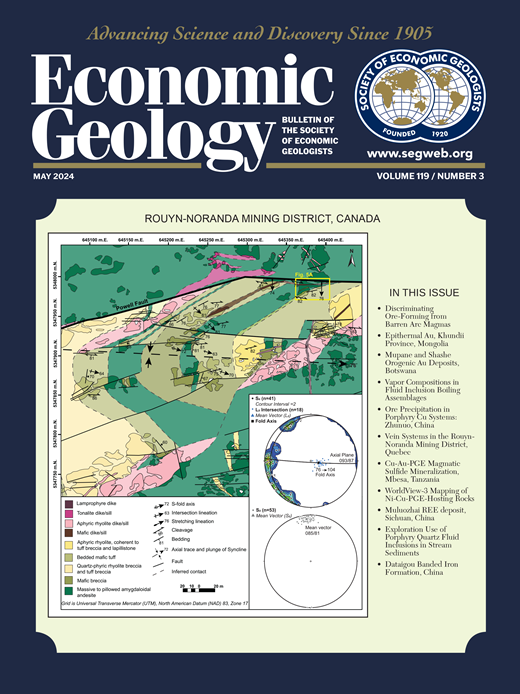Alkaline-Silicate REE-HFSE Systems
IF 5.5
1区 地球科学
Q1 GEOCHEMISTRY & GEOPHYSICS
引用次数: 6
Abstract
Abstract Development of renewable energy infrastructure requires critical raw materials, such as the rare earth elements (REEs, including scandium) and niobium, and is driving expansion and diversification in their supply chains. Although alternative sources are being explored, the majority of the world’s resources of these elements are found in alkaline-silicate rocks and carbonatites. These magmatic systems also represent major sources of fluorine and phosphorus. Exploration models for critical raw materials are comparatively less well developed than those for major and precious metals, such as iron, copper, and gold, where most of the mineral exploration industry continues to focus. The diversity of lithologic relationships and a complex nomenclature for many alkaline rock types represent further barriers to the exploration and exploitation of REE-high field strength element (HFSE) resources that will facilitate the green revolution. We used a global review of maps, cross sections, and geophysical, geochemical, and petrological observations from alkaline systems to inform our description of the alkaline-silicate REE + HFSE mineral system from continental scale (1,000s km) down to deposit scale (~1 km lateral). Continental-scale targeting criteria include a geodynamic trigger for low-degree mantle melting at high pressure and a mantle source enriched in REEs, volatile elements, and alkalies. At the province and district scales, targeting criteria relate to magmatic-system longevity and the conditions required for extensive fractional crystallization and the residual enrichment of the REEs and HFSEs. A compilation of maps and geophysical data were used to construct an interactive 3-D geologic model (25-km cube) that places mineralization within a depth and horizontal reference frame. It shows typical lithologic relationships surrounding orthomagmatic REE-Nb-Ta-Zr-Hf mineralization in layered agpaitic syenites, roof zone REE-Nb-Ta mineralization, and mineralization of REE-Nb-Zr associated with peralkaline granites and pegmatites. The resulting geologic model is presented together with recommended geophysical and geochemical approaches for exploration targeting, as well as mineral processing and environmental factors pertinent for the development of mineral resources hosted by alkaline-silicate magmatic systems.碱硅酸盐REE-HFSE系统
可再生能源基础设施的发展需要关键原材料,如稀土元素(ree,包括钪)和铌,并正在推动其供应链的扩张和多样化。虽然正在探索其他来源,但世界上这些元素的大部分资源是在碱硅酸盐岩石和碳酸盐岩中发现的。这些岩浆系统也代表了氟和磷的主要来源。与主要金属和贵重金属,如铁、铜和金的勘探模式相比,关键原材料的勘探模式相对欠发达,而大多数矿物勘探工业继续把重点放在这些金属上。岩性关系的多样性和许多碱性岩石类型的复杂命名进一步阻碍了ree -高场强元素(HFSE)资源的勘探和开发,这将促进绿色革命。我们对碱矿系统的地图、横截面以及地球物理、地球化学和岩石学观测资料进行了全球回顾,以描述从大陆尺度(1,000公里)到矿床尺度(横向约1公里)的碱硅酸盐REE + HFSE矿物系统。大陆尺度的目标标准包括高压下低程度地幔熔融的地球动力学触发因素和富含稀土、挥发性元素和碱的地幔源。在省、区尺度上,定位标准与岩浆系统寿命、广泛分馏结晶和稀土、氢氟硅矿残余富集所需的条件有关。地图和地球物理数据的汇编用于构建交互式三维地质模型(25立方公里),该模型将矿化置于深度和水平参考框架内。显示了层状无辉岩正岩浆REE-Nb-Ta- zr - hf矿化、顶带REE-Nb-Ta矿化以及与过碱性花岗岩和伟晶岩相关的REE-Nb-Zr矿化的典型岩性关系。提出了相应的地质模型,并推荐了物探和化探方法,以及与碱硅酸盐岩浆系统矿产资源开发相关的矿物加工和环境因素。
本文章由计算机程序翻译,如有差异,请以英文原文为准。
求助全文
约1分钟内获得全文
求助全文
来源期刊

Economic Geology
地学-地球化学与地球物理
CiteScore
10.00
自引率
6.90%
发文量
120
审稿时长
6 months
期刊介绍:
The journal, now published semi-quarterly, was first published in 1905 by the Economic Geology Publishing Company (PUBCO), a not-for-profit company established for the purpose of publishing a periodical devoted to economic geology. On the founding of SEG in 1920, a cooperative arrangement between PUBCO and SEG made the journal the official organ of the Society, and PUBCO agreed to carry the Society''s name on the front cover under the heading "Bulletin of the Society of Economic Geologists". PUBCO and SEG continued to operate as cooperating but separate entities until 2001, when the Board of Directors of PUBCO and the Council of SEG, by unanimous consent, approved a formal agreement of merger. The former activities of the PUBCO Board of Directors are now carried out by a Publications Board, a new self-governing unit within SEG.
 求助内容:
求助内容: 应助结果提醒方式:
应助结果提醒方式:


